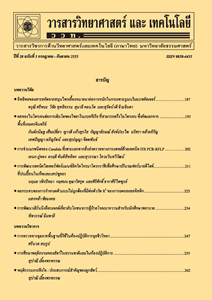การกำจัดตะกั่วในน้ำเสียอุตสาหกรรมโดยใช้ถ่านกัมมันต์จากไม้มะขามที่ผ่านการกระตุ้นด้วยกรดฟอสฟอริก
Main Article Content
Abstract
บทคัดย่อ
การวิจัยนี้มีวัตถุประสงค์เพื่อศึกษาการกำจัดตะกั่ว(II) ไอออนในสารละลายด้วยการดูดซับโดยใช้ถ่านกัมมันต์ จากไม้มะขามเตรียมได้จากการกระตุ้นด้วยกรดฟอสฟอริก และนำไปใช้กำจัดสารตะกั่วในน้ำเสียจากอุตสาหกรรม พบว่าถ่านกัมมันต์จากไม้มะขามมีรูปแบบการเลี้ยวเบนของรังสีเอ็กซ์ที่ตำแหน่งมุม 2-ทีตา 25.58 และ 44.56 องศา และค่าไอโอดีน 725 มิลลิกรัมต่อกรัม แสดงให้เห็นว่าการเตรียมถ่านกัมมันต์จากไม้มะขามประสบความสำเร็จ ส่วนการกำจัดตะกั่ว(II) ไอออนในสารละลายศึกษาโดยการแปรผันปัจจัยต่าง ๆ ในการดูดซับ ผลการทดลองพบว่าภาวะที่เหมาะสมในการดูดซับตะกั่ว(II) ไอออนในสารละลายด้วยถ่านกัมมันต์จากไม้มะขาม คือ ค่าความเป็นกรด-ด่างของสารละลาย 5.0 เวลาในการปั่นกวน 60 นาที และปริมาณตัวดูดซับ 2.0 กรัมต่อลิตร จลนศาสตร์การดูดซับตะกั่ว(II) ไอออนบนถ่านกัมมันต์จากไม้มะขามในสารละลาย เป็นไปตามแบบจำลองอันดับสองเทียม (ค่าสัมประสิทธิ์สหสัมพันธ์ เท่ากับ 1.000) แสดงว่าเกิดการดูดซับทางเคมี จากนั้นศึกษาไอโซเทอร์มการดูดซับตะกั่ว(II) ไอออนในสารละลายของถ่านกัมมันต์จากไม้มะขาม (ความเข้มข้นเริ่มต้นของสารละลายตะกั่ว(II) ไอออน 10-250 มิลลิกรัมต่อลิตร) พบว่าไอโซเทอร์มการดูดซับเป็นไปตามแบบแลงเมียร์ (ค่าสัมประสิทธิ์สหสัมพันธ์ เท่ากับ 1.000) เกิดการดูดซับแบบชั้นเดียวบนผิวของถ่านกัมมันต์จากไม้มะขาม ค่าความจุการดูดซับตะกั่ว(II) ไอออนสูงสุดในสารละลายของถ่านกัมมันต์จากไม้มะขามเท่ากับ 19.06 มิลลิกรัมต่อกรัม และค่าปัจจัยของการแยก (RL) มีค่า 0.001-0.030 แสดงว่าการดูดซับตะกั่ว(II) ไอออนบนถ่านกัมมันต์จากไม้มะขามเกิดได้อย่างดี นอกจากนี้ถ่านกัมมันต์จากไม้มะขามมีประสิทธิภาพที่ดีกว่าถ่านจากไม้มะขามในการกำจัดสารตะกั่วในน้ำเสียจากอุตสาหกรรมผลิตสีทาอาคารและบ้านเรือน มีค่าร้อยละของกำจัดสารตะกั่วในน้ำเสียจากอุตสาหกรรมผลิตสีทาอาคารและบ้านเรือน 100.00±0.00 และ 12.68±0.11 ตามลำดับ
คำสำคัญ : ถ่านกัมมันต์; ไม้มะขาม; การดูดซับ; ตะกั่ว(II) ไอออน
Abstract
The objective of this research is studied for the removal of Pb2+ in solution with the adsorption by using the activated carbon from Tamarind wood via H3PO4 activation. The application was the removal of lead in industrial wastewater. It was found that the activated carbon from Tamarind wood has the XRD patterns of the presence of peaks at 2θ of 25.58° and 44.56°. Iodine number is 725 mg g-1. The results shown that the activated carbon from Tamarind wood was successfully preparaed. The various of the adsorption parameters were observed for the removal of Pb2+ in solution. The results were found that the optimum condition for the adsorption of Pb2+ by using the activated carbon from Tamarind wood in solution were 5.0 of pH in solution, 60 min of contact time and 2.0 g L-1 of adsorbent dose. The adsorption kinetic of Pb2+ onto the activated carbon from Tamarind wood in solution followed the pseudo-second order model (correlation coefficient (R2) = 1.000), which indicated that the adsorption occurred via chemisorptions. Then, the adsorption isotherms of the activated carbon from Tamarind wood for the removal of Pb2+ in solution were investigated (10-250 mg L-1 of the initial concentrations of Pb2+ solution). It was found that the adsorption isotherm followed the Langmuir model (R2 = 1.000), which was assumed that the monolayer adsorption occurred onto the activated carbon surface from Tamarind wood. The maximum adsorption capacity of the activated carbon from Tamarind wood was 19.06 mg L-1 for Pb2+ in solution. The separation factors (RL) are between 0.001 to 0.030, which indicate that the adsorption of Pb2+ onto the activated carbon from Tamarind wood is favorable. In addition, the activated carbon from Tamarind wood is higher efficiency than the charcoal from Tamarind wood for the Lead removal in the paint industrial wastewater. The removal percentages of the activated carbon and the charcoal from Tamarind wood of Pb2+ in the paint industrial wastewater were 100.00±0.00 and 12.68±0.11, respectively.
Keywords: activated carbon; tamarind wood; adsorption; Pb2+


